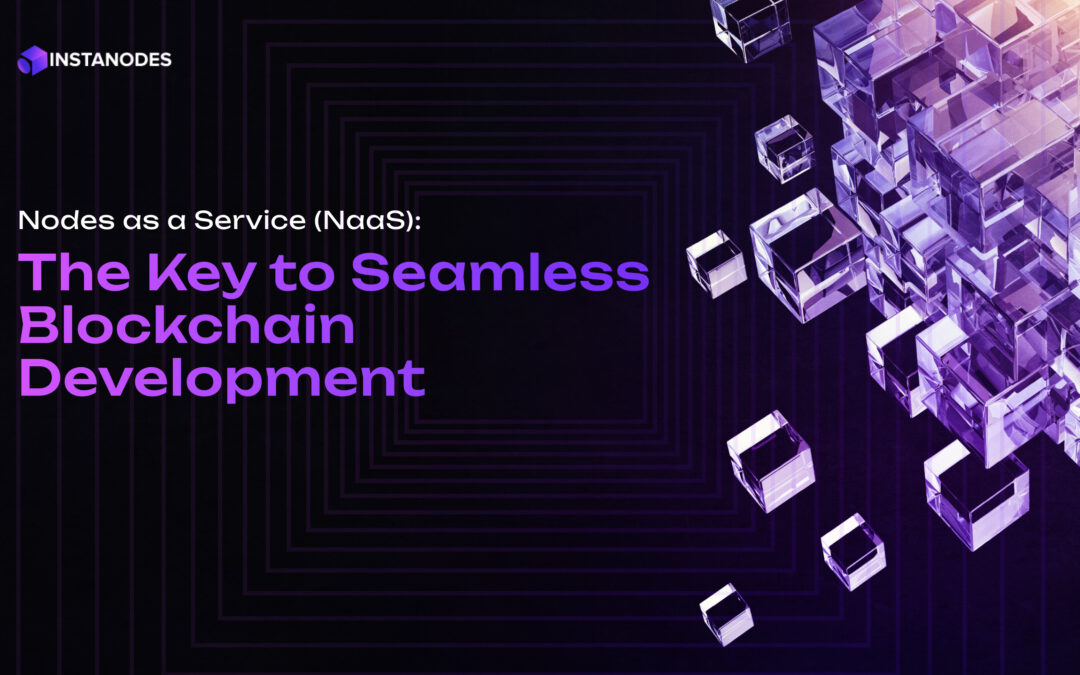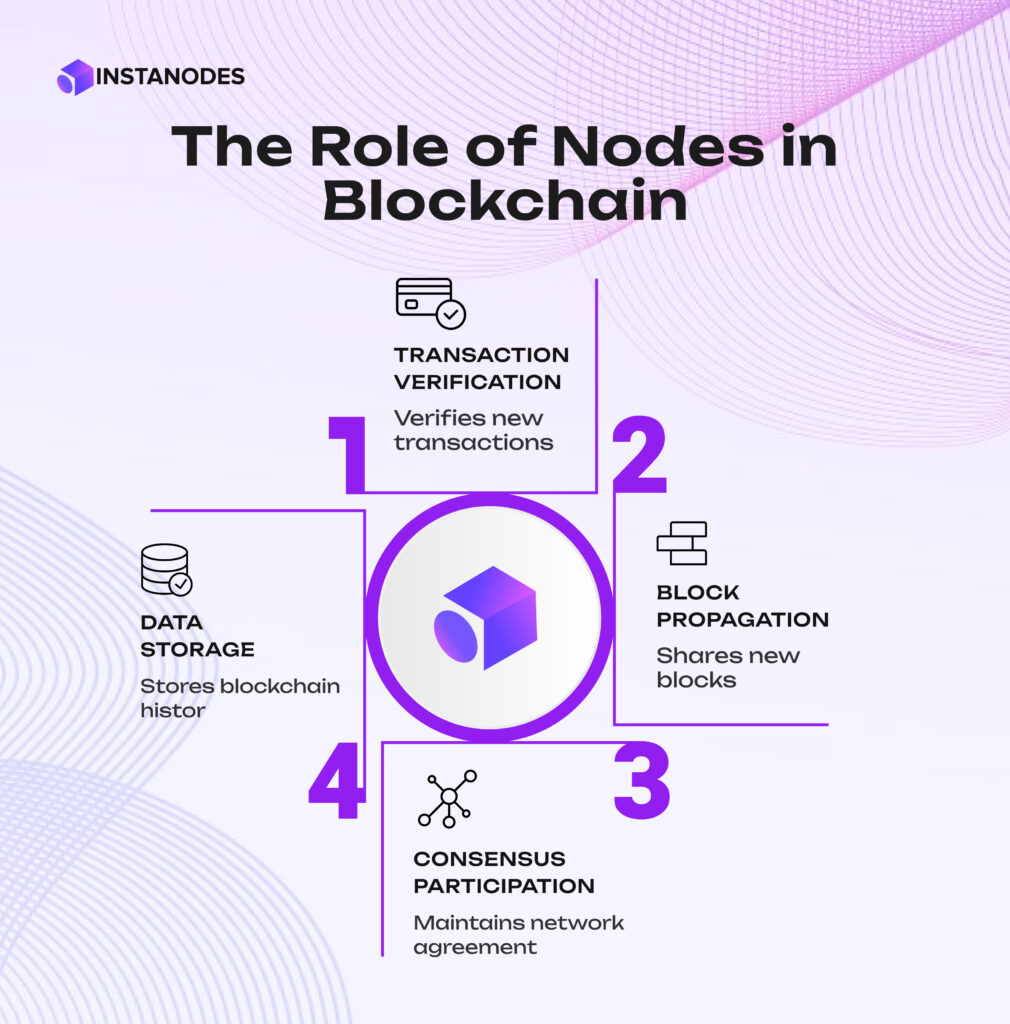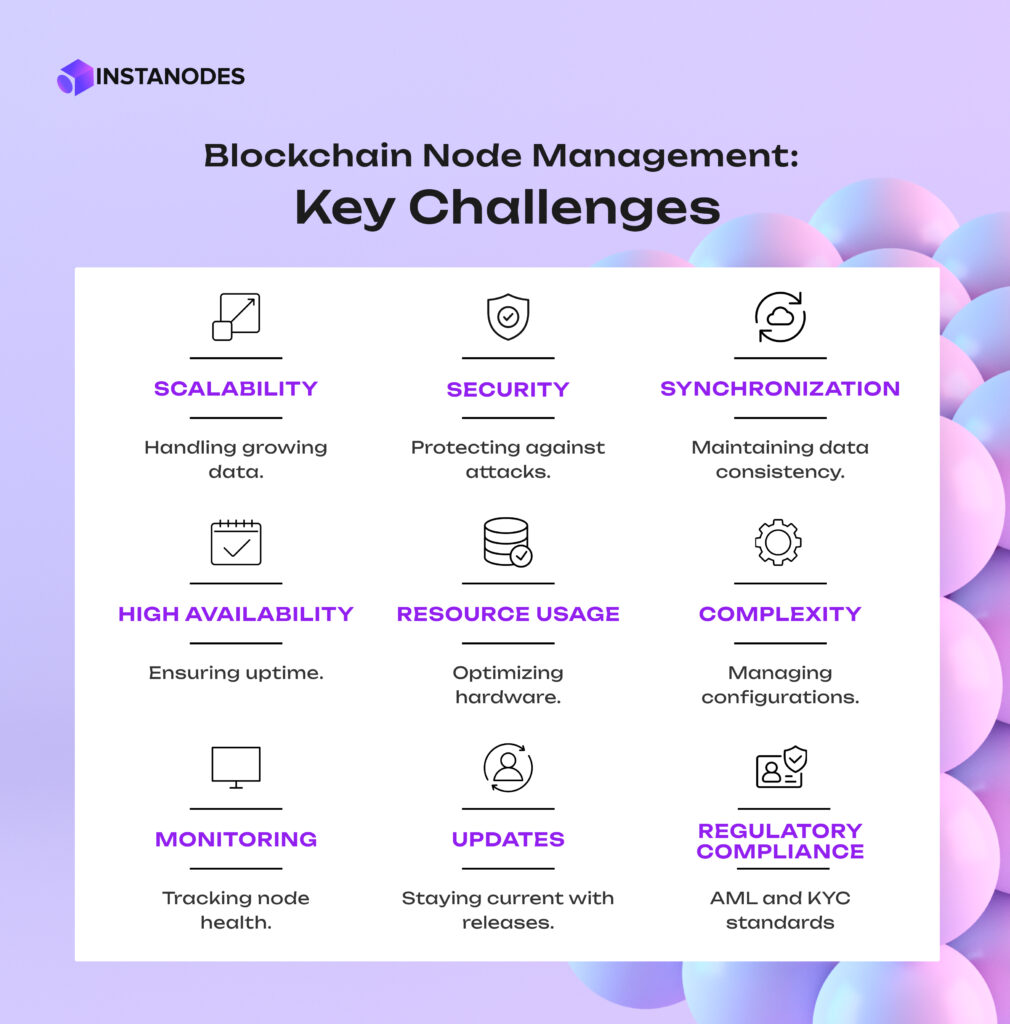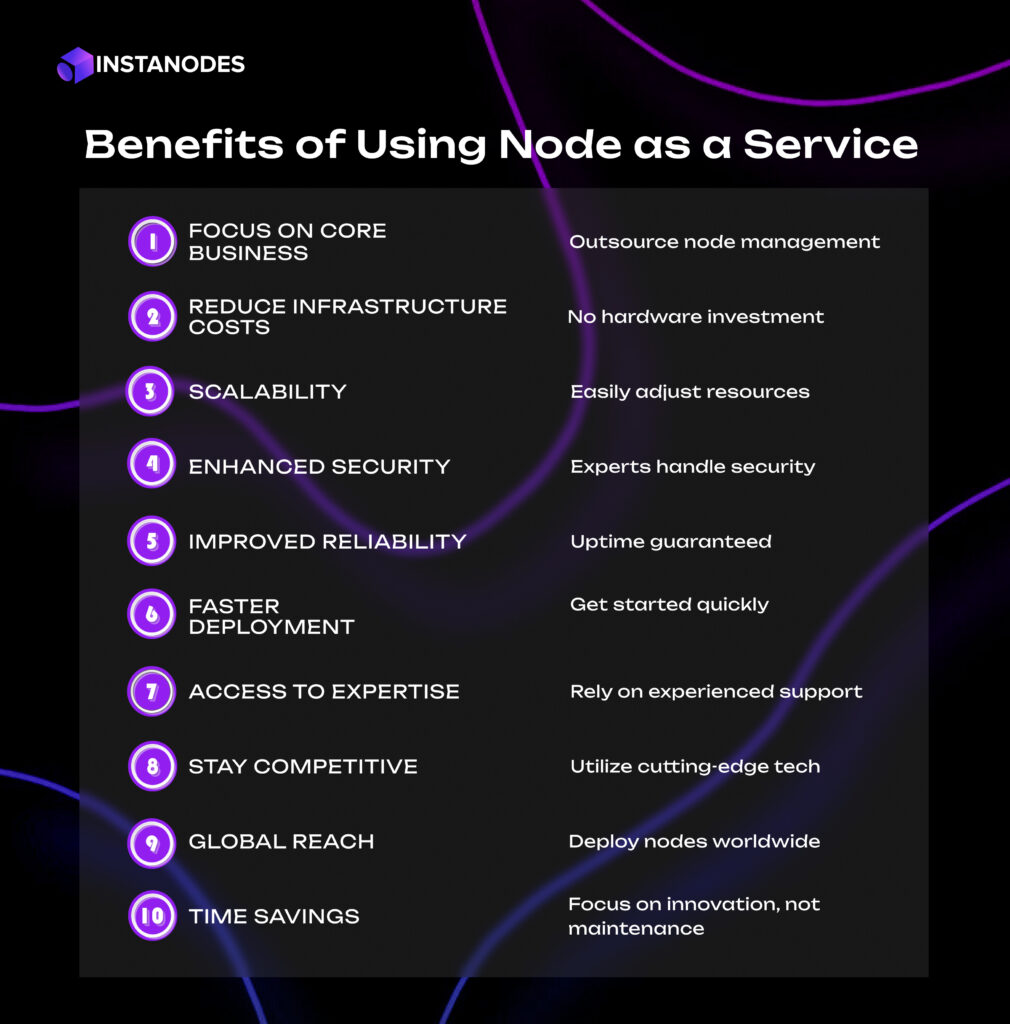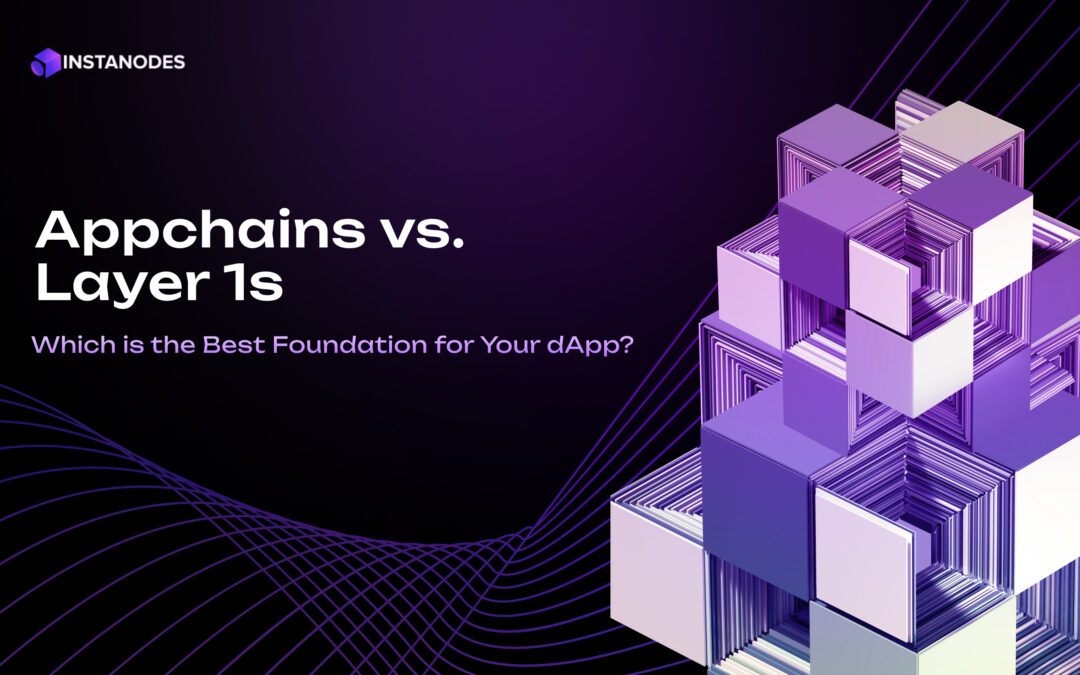
Appchains vs. Layer-1 Solutions: Which is Right for Your DApp?
Blockchain technology has experienced an amazing journey since it emerged as the basis of technology behind Bitcoin. All the initial L1 blockchains such as Bitcoin and Ethereum existed as the bottom layer, and all transactions and smart contracts were directly managed by them.
Yet, when adoption of blockchain increased, L1s also became scalability-inclined and their transaction charges soared high with low processing times. This paved the way for Layer 2 (L2) solutions such as Lightning Network and rollups that work over L1s to execute transactions off-chain in order to improve throughput and cut down expenses.
Later, more innovation caused the development of Layer 3 (L3) solutions that concentrated on a particular functionality such as data storage or identity management, typically implemented on top of L2s or even L1s. These layers establish a more efficient and modular blockchain ecosystem.
The concept of AppChains emerged with Cosmos SDK (2019), enabling independent, customizable blockchains
Currently, the concept of Appchain, or Application Specific Blockchain have attracted more attention in recent times. In contrast to general-purpose L1s, AppChains are application-specific blockchains for a single use case or a limited number of related use cases. Developers can then design the blockchain for their specific dApp needs, providing more control over performance, security, and governance. This shift away from monolithic L1s to a more complex multi-layered and appchain-based architecture is the result of the ever-present search for scalability, efficiency, and customization in the blockchain world.
| Layer 1 vs. Appchains: A Detailed Comparison | ||
| Aspect | Layer 1 dApps | Appchains |
| Definition | Independent, foundational blockchain. | Standalone blockchain optimized for a specific application. |
| History & Evolution | Layer 1 blockchains like Bitcoin and Ethereum have evolved as the foundation of decentralized networks. | Appchains emerged to address scalability and customization limitations of Layer 1 networks. |
| Core Purpose | General-purpose, hosting diverse applications. | Specialized, focused on a single application or use case. |
| Security | Highly secure due to robust consensus mechanisms and network participation. | Security depends on individual chain design, sometimes requiring additional measures. |
| Scalability | Often limited, leading to congestion and high fees. | Highly scalable as they operate independently with customized throughput. |
| Customization | Limited customization due to predefined protocols and governance. | Fully customizable, allowing projects to tailor features to specific needs. |
| Transaction Costs | Can be high due to network congestion. | Generally lower, as each appchain manages its own resources. |
| Development Complexity | Easier to deploy on existing Layer 1 networks. | Requires setting up an independent blockchain, making development more complex. |
| Network Effects | Strong, benefiting from large user bases and liquidity. | Initially weaker network effects, requiring effort to attract users and developers. |
| Governance | Typically governed by a decentralized community or foundation. | Projects have full control over governance and updates. |
| Interoperability | Composability with existing dApps and DeFi protocols. | Often requires bridges or interoperability solutions. |
| Use Cases | Suitable for DeFi, NFT marketplaces, and general-purpose dApps. | Best for high-performance applications like gaming, derivatives trading, and niche ecosystems. |
| Reliance on External Infrastructure | Relies on the core infrastructure of Layer 1 blockchain providers. | Independent, with full control over infrastructure and consensus mechanisms. |
| Adoption & Ecosystem Growth | Easier adoption due to existing communities and developer tools. | Requires dedicated efforts to build an ecosystem from scratch. |
Understanding the Core Trade-offs: Security vs Performance vs Customization
While making a choice between an AppChain and a Layer-1 blockchain for dApp development, your concern must be on the aspects of security, performance, and customization.
- Security
Layer-1 blockchains such as Ethereum, Solana, and Avalanche have solid security anchored by a large number of validators or miners. They are resistant to attacks due to their high degree of decentralization, but this security is at the expense of scalability and gas fees that are too high.
Conversely, an AppChain crypto is specifically built for a particular application—enables developers to add their own security measures. Maintaining the security of a chain application is done either by establishing its own validator network or by benefiting from shared security tools, e.g., those of Polkadot’s parachains or Cosmos’ zones.
- Performance
Layer-1 networks are likely to suffer from congestion as a result of heavy usage, resulting in slower transactions and increased fees. AppChain, being explicitly for a particular dApp, offers better performance by handling only applicable transactions, which leads to increased throughput and reduced latency.
- Customization
Layer-1 solutions have less flexibility since they have to serve a wide array of applications. AppChains provide full control over the execution environment, consensus mechanism, and governance model and are best for dApps that need special tweaks that cannot easily be done on a Layer-1 blockchain.
Economic Considerations: Token Economics, Validator Incentives, and Launch Costs
- Token Economics
Layer-1 blockchains generally come with native tokens (ETH, SOL, etc.) that are employed for network security and transaction fees. dApps operating on such networks are forced to use these native tokens or launch their own ERC-20 tokens with added layers of complexity. Application Specific Blockchain, however, allows projects to mint their own native tokens, offering more control over token utility, gas fees, and governance.
- Validator Incentives
Operating an application chain necessitates motivating validators or stakers to lock up their tokens and maintain the network. On Layer-1 networks, validators are already built and motivated with block rewards and transaction fees. AppChain developers need to bootstrap their own validator economy, however, which is complicated and expensive.
- Launch Costs
Deploying on a Layer-1 blockchain tends to be cheaper for nascent projects as it avoids the hassle of creating and managing a separate network. AppChains, though providing long-term economic advantages, involve high upfront and operational costs, such as validator incentives, security measures, and infrastructure management.
Development Experience: Comparing Tooling & Documentation, and Time-to-Market
The choice between a Layer-1 blockchain and an Application Specific Blockchain should also be based on development perspective.
- Tooling & Documentation
Layer-1 ecosystems like Ethereum offer a deep developer environment with advanced tooling such as Solidity, Hardhat, Truffle, and widely documented SDKs. Application chain might take a higher learning curve, depending on the ecosystem (Cosmos SDK, Substrate, subnet framework of Avalanche). Developers would need to get accustomed to new tooling.
- Time-to-Market
Developing on a proven Layer-1 blockchain enables quicker development, considering the pre-existing templates for smart contracts and huge community support. One needs to make extra effort to install and test a chain application, resulting in extended development times.
Scalability Solutions: How L1 & AppChains Handle Growing Transaction Volumes
- Layer-1 Scalability
Legacy Layer-1 solutions are built upon upgrades such as sharding (Ethereum 2.0), Layer-2 rollups, and off-chain scaling solutions for handling increasing numbers of transactions. Although these help increase throughput, they can have the added drawback of complexity when integrating with existing infrastructure and smart contracts.
- AppChain Scalability
AppChains naturally scale better because they are only devoted to one application, which precludes traffic congestion from unrelated transactions. Projects are able to customize block generation rates, consensus models, and resource utilization to fit their particular demands, which can achieve much greater transaction volume than generalized Layer-1 blockchains.
Cross-chain Interoperability: Managing Asset Transfers and Data Flow
It’s crucial to consider interoperability when making a choice between an application chain and a Layer-1 blockchain.
- Layer-1 Interoperability
The majority of Layer-1 blockchains boast established bridges and liquidity solutions such that dApps can communicate across several networks. Yet, the bridges tend to bring security risks and extra fees.
- AppChain Interoperability
An Application Specific Blockchain, specifically that runs on Cosmos (IBC protocol) or Polkadot (XCMP protocol), provides intrinsic cross-chain interoperability. It allows assets and information to be moved freely across multiple blockchains without needing to be dependent on third-party bridges.
Development & Deployment: Which Path Offers a Smoother Ride for Your dApp?
In the context of development and deployment of a dApp, making a choice between a Layer 1 blockchain and a chain application has a very significant effect on the process’s ease.
Layer 1 blockchains such as Ethereum and Solana offer a well-established infrastructure with established security, liquidity, and development tools. The smart contracts are readily deployed using popular programming languages such as Solidity with the backing of a robust community. Yet, scalability concerns, high gas costs, and congestion can affect performance, which makes Layer 1 less desirable for high-volume application needs.
On the other hand, AppChains extend a more customized environment, in which the developers are able to fine-tune network parameters to suit their use case. This provides superior performance, reduced transaction fees, and more flexibility. Nevertheless, the creation of an appchain crypto involves establishing a separate network, securing validators, and ensuring interoperability, which is more effort- and resource-intensive. The decision hinges on whether a project needs speed and convenience (Layer 1) or control and scalability (chain application).
When to Choose a Layer 1 Blockchain for Your DApp
A Layer-1 blockchain is the right choice for your dApp if:
- You prioritize security and decentralization over customization.
- You need a fast, cost-effective deployment without managing your own validator network.
- Your application requires existing liquidity and seamless user onboarding.
- You plan to leverage an established developer ecosystem with mature tools and documentation.
When to Consider an Application Specific Blockchain for Your DApp
Opt for an AppChain crypto solution if:
- Your dApp demands high scalability and predictable transaction fees.
- You require full control over governance, execution environments, and security.
- You want to create a custom token economy with specific incentives for validators and users.
- Your project involves complex interoperability with other chains and benefits from a dedicated blockchain infrastructure.
Challenges and Solutions When Migrating from a Layer 1 Blockchain to an Appchain
Moving from an L1 blockchain (such as Ethereum, Solana, etc.) to an appchain (application-specific blockchain) is a strategic decision that can provide great benefits such as more customization, performance, and control. However, it comes with a special set of challenges. Here’s the analysis of those challenges and probable solutions:
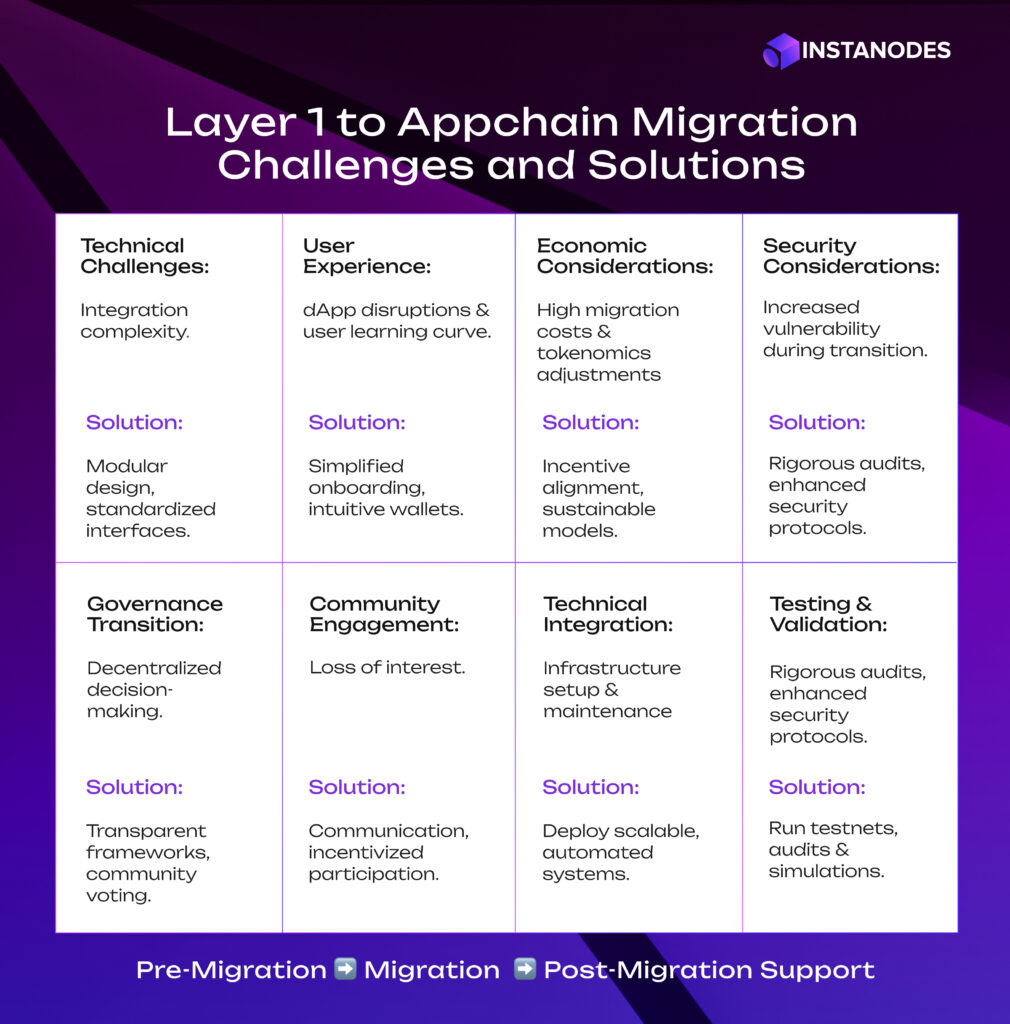
A. Technical Challenges and Solutions
- State Migration
Challenge: Transferring existing state data, including user balances, NFTs, and smart contract storage.
Solution:
- Implement a snapshot mechanism to capture the complete state at a specific block height
- Create automated migration scripts with thorough validation
- Use merkle proofs to verify state consistency
- Deploy state migration contracts on both chains for coordinated transfer
- Smart Contract Adaptation
Challenge: Modifying existing smart contracts for the new appchain environment.
Solution:
- Audit and refactor contracts to leverage appchain-specific features
- Implement comprehensive testing suites for the new environment
- Use contract upgradeability patterns for smooth transitions
- Create compatibility layers where needed
B. User Experience Challenges
- Wallet Integration
Challenge: Ensuring users can seamlessly transition to the new chain.
Solution:
- Develop clear migration guides for users
- Create automated wallet configuration tools
- Implement bridge interfaces for asset transfers
- Provide fallback mechanisms for accessing old chain data
- Transaction History
Challenge: Maintaining access to historical transaction data.
Solution:
- Archive Layer 1 data in accessible formats
- Create unified explorers that show data from both chains
- Implement historical data APIs
- Maintain read-only access to the original chain
C. Economic Considerations
- Token Migration
Challenge: Managing the transition of tokens and maintaining value.
Solution:
- Design clear token migration schedules
- Implement lock-and-mint mechanisms
- Create incentives for early migration
- Maintain liquidity on both chains during transition
- Validator Transition
Challenge: Establishing a new validator set for the appchain.
Solution:
- Create validator onboarding programs
- Design incentives for early validators
- Implement gradual stake migration
- Provide technical support for validator setup
D. Security Considerations
- Bridge Security
Challenge: Securing cross-chain asset transfers during migration.
Solution:
- Implement multi-signature validation
- Use time-locks for large transfers
- Deploy monitoring systems
- Conduct thorough security audits
- Network Security
Challenge: Ensuring adequate security for the new chain.
Solution:
- Gradually build validator stake
- Implement additional security measures during early stages
- Monitor network health metrics
- Have emergency response procedures ready
E. Governance Transition
- Decision Making
Challenge: Transitioning governance mechanisms and stakeholder participation.
Solution:
- Create clear governance migration plans
- Implement parallel governance systems during transition
- Maintain communication channels
- Document decision-making processes
- Community Engagement
Challenge: Maintaining community support during migration.
Solution:
- Regular progress updates
- Clear communication of benefits
- Community feedback mechanisms
- Incentives for participation
F. Technical Integration
- API Compatibility
Challenge: Maintaining service integration for existing dApps.
Solution:
- Provide compatibility layers
- Create comprehensive API documentation
- Offer technical support for integration
- Implement fallback mechanisms
- Infrastructure Setup
Challenge: Establishing reliable infrastructure for the appchain.
Solution:
- Deploy distributed node infrastructure
- Implement monitoring systems
- Create backup mechanisms
- Establish performance benchmarks
G. Operational Considerations
- Timeline Management
Challenge: Coordinating the migration process across all stakeholders.
Solution:
- Create detailed migration roadmaps
- Set clear milestones and checkpoints
- Implement progress tracking systems
- Maintain flexibility for adjustments
- Resource Allocation
Challenge: Managing development and operational resources during transition.
Solution:
- Clear budget allocation
- Team responsibility assignment
- Third-party support identification
- Contingency resource planning
H. Testing and Validation
- Migration Testing
Challenge: Ensuring thorough testing of all migration components.
Solution:
- Create comprehensive test environments
- Conduct multiple testnet migrations
- Implement automated testing suites
- Perform stress testing of critical components
- Performance Verification
Challenge: Validating performance improvements on the appchain.
Solution:
- Establish clear performance metrics
- Conduct comparative analysis
- Monitor user experience impacts
- Document performance gains
I. Post-Migration Support
- Ongoing Maintenance
Challenge: Managing both chains during the transition period.
Solution:
- Clear maintenance schedules
- Dedicated support teams
- Monitoring systems
- Regular health checks
- User Support
Challenge: Providing adequate support for users during and after migration.
Solution:
- Dedicated support channels
- Comprehensive documentation
- FAQs and troubleshooting guides
- Community support networks
This comprehensive approach to migration challenges ensures a smoother transition from Layer 1 to an Appchain while maintaining security, user experience, and operational efficiency throughout the process.
Real-World Examples: Success Stories and Use Cases of Layer 1 dApps and Appchains
Developers face a key choice: build dApps on existing Layer 1s or launch independent appchains. Let’s examine how both approaches work in practice.
Success Stories of Layer 1 dApps
Layer 1 blockchains like Ethereum, Solana, and Avalanche offer a safe and decentralized ecosystem for dApps. These blockchains have hosted some of the most successful applications in DeFi, gaming, and NFTs.
Uniswap (Ethereum – DeFi)
Uniswap is among the most famous DEXs built on Ethereum. It facilitates seamless token swaps in the absence of intermediaries, with assurance of robust security and liquidity. The platform introduced automated market makers (AMMs), which completely changed the way of conducting decentralized trading. Uniswap is still the most preferred DEX despite network clogging and exorbitant gas prices because Ethereum has an enormous user base as well as strong security.
Axie Infinity (Ronin & Ethereum – Gaming/NFTs)
The launch of Axie Infinity was done using Ethereum but it encountered scalability issues which resulted in high costs per transaction. To resolve this, its creators launched Ronin (an Ethereum sidechain), which is specifically designed for gaming transactions. The game also set the precedent for the Play-to-Earn (P2E) model, enabling gamers to derive real-world earnings from NFTs. Axie Infinity’s success illustrates that dApps can first use Layer 1 chains and then move on to bespoke chains when scalability becomes a constraint.
Aave (Ethereum & Polygon – DeFi Lending)
Aave, a decentralized borrowing and lending protocol, began on Ethereum but has since diversified to Layer 2 solutions such as Polygon in an effort to combat gas prices. Aave owes its success to Ethereum security and liquidity that draws institutional and retail users to the platform. With decentralized lending offered through overcollateralized loans, Aave has positioned itself as an essential part of the DeFi world.
OpenSea (Ethereum & Polygon – NFT Marketplace)
The largest NFT marketplace, OpenSea depends on Ethereum for securing its digital assets. In light of Ethereum’s scalability challenges, it included Polygon to provide retail users with lower transaction fees. This dual approach provides OpenSea with Ethereum’s trust while enhancing user accessibility.
Success Stories of Appchains
Unlike Layer 1 dApps, appchains are independent blockchain ecosystems tailored for specific applications. They offer greater control, scalability, and customization for projects that require optimized performance.
dYdX (Cosmos – Decentralized Derivatives Exchange)
Originally developed on Ethereum, dYdX moved to the Cosmos ecosystem to develop its own appchain. Making a switch helped the platform to execute high throughput, low latency, and have better control over transaction fees. By creating a purpose-built blockchain for decentralized derivatives trading, dYdX provides a seamless experience for users without the limitations of Ethereum’s network congestion.
DeFi Kingdoms (Avalanche Subnet – Gaming/DeFi Hybrid)
DeFi Kingdoms, a gamified DeFi platform, migrated from Harmony to its own Avalanche subnet to scale effectively. This enabled the project to maximize transaction speed and tailor economic incentives for its ecosystem. By using an appchain, DeFi Kingdoms can have more control over its network parameters and provide seamless gameplay and financial interactions.
Ronin (Ethereum Sidechain – Gaming & NFTs)
As already stated, Ronin was designed for Axie Infinity to avoid Ethereum’s excessive fees. This sidechain paradigm is a great example of how gaming apps can take advantage of appchains. Ronin gave Axie Infinity cheaper transaction fees and quicker confirmation times, which resulted in widespread adoption and considerable economic activity within the game.
Helium (Solana – Decentralized Wireless Network)
Helium, initially developed on its own blockchain, moved to Solana for improved scalability and interoperability. Nevertheless, its past appchain model allowed it to establish an innovative decentralized wireless network, in which users get rewarded for supplying IoT and 5G connectivity. This application case illustrates how appchains can be optimized for particular real-world infrastructure requirements.
Final Thoughts
Building a dApp? Choosing between a Layer 1 blockchain and an AppChain might be a tough call. However, it should be made according to your dApp’s specific needs, such as scalability, security, and customization. Layer 1 options provide a solid, battle-proven base with high liquidity and network effects, which are best suited for general-purpose applications.
However, if your project demands greater control, high-performance execution, and reduced transaction fees, then an Application Specific Blockchain is the way forward. Appchains provide room for customization in consensus algorithms, governance models, and transactional rules, delivering an application-specific ecosystem.
It can be challenging to make the transition from a Layer 1 blockchain to an AppChain, with areas of expertise needed in security, interoperability, and deployment. Instanodes, the renowned AppChain developer, is here to simplify the process of transition from Layer 1 to an Application Specific Blockchain, making the migration experience seamless.
Prepare yourself to smoothly deploy and operate your application chain while ensuring interoperability with the current ecosystems. Open the door to new scalability and efficiency opportunities without encountering the usual difficulties in blockchain migration. Connect with us now!
